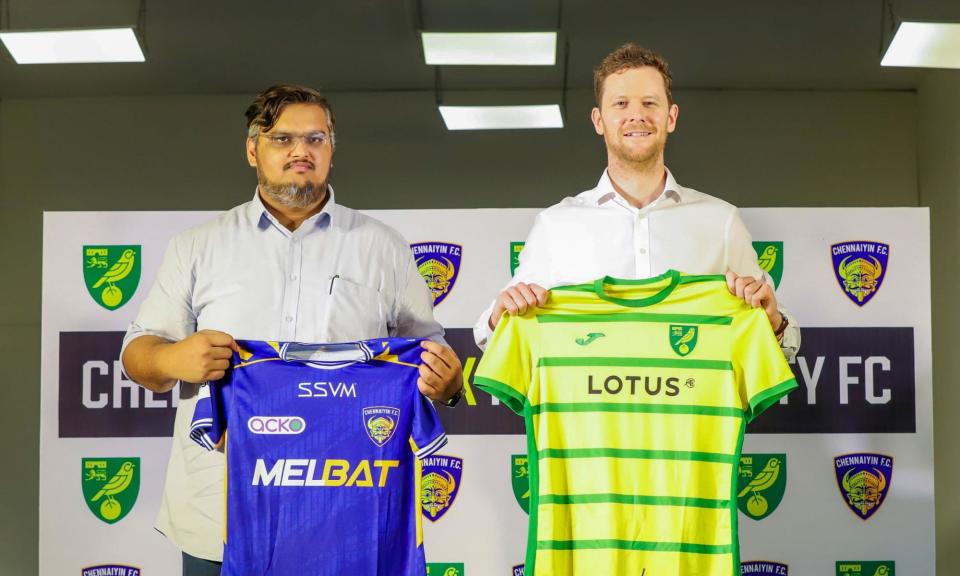‘Football’s on the rise here’: European teams seek global outreach in India

A south Indian Idli Sambar mixed with Norfolk mustard was on the menu when Norwich City and Chennaiyin FC announced a strategic partnership last week. The Canaries are the latest European club to head to the subcontinent in search of fans, revenue and, eventually perhaps, talent. If India has overtaken China as the world’s most populous country, it is also increasingly seen as the place to be in football.
The big clubs are still active in China but operating there was far from simple even before the pandemic helped to produce a more inward-looking and insular business environment. It can be hard for European officials to get to grips with a lack of transparency, the language and a completely different social media model as well as concerns over corruption. Chinese companies and business people got heavily involved in European football for a while but there have been few attempts to go the other way – Sheffield United’s ownership of Chengdu Blades, starting in 2006, had its moments but did not last long.
Enter India, or rather, enter European clubs in India. The Indian Super League (ISL) was formed in 2014 as a standalone tournament involving eight teams. It has grown to 12 and become the top tier of the country’s pyramid. The original big-name players such as Alessandro Del Piero have gone but the tournament has settled and with the promotion of Mohammedan Sporting to join their neighbours and Kolkata giants, East Bengal and Mohun Bagan, the ISL will have three clubs next season with more than 100 years of history along with some newer franchises.
Related: One change could take India to the football World Cup. Will they make it?
A growing number have partners from the west. To mention a few: Rangers have been involved with their fellow blues Bengaluru, Borussia Dortmund became partners with Hyderabad in 2020, Fiorentina linked with FC Pune and RB Leipzig have tied up with FC Goa. Basel became involved with Chennai City of the I-League and the City Football Group has a 65% stake in Mumbai City, a club that have gone on to lift trophies and compete in the Asian Champions League. There was also success when Atlético Madrid had a partnership with Atlético De Kolkata (ATK) in the early ISL days.
“India is a huge market and they are huge fans of European football,” says Shaji Prabhakaran, a former general secretary of the All India Football Federation. “That is the obvious attraction.” The attraction is clear on the opposite side too.
“Indian clubs want knowhow for player development, coach education and other strategies,” he says. “Many are new and can learn a lot from teams like Norwich in various aspects. Chennai are one of the better clubs in India and they have a focus on grooming talent so they can get Norwich’s support in building players and expertise, which can help local football in the local catchment area.” He is reserving judgment, however. “Every partnership is signed with a lot of hope but so far we have yet to really see a case study of how it can work and if it can become a win-win situation.”
Baljit Rihal is the founder of Inventive Sports, a global sports agency with years of experience in linking European and Indian football. “The partnership between Atlético Madrid and ATK stood out for showing genuine commitment and intent, until the Indian stakeholders eventually acquired Atlético’s shares,” he says. That was in 2017. “Similarly, the City Football Group’s investment in Mumbai City FC in 2020 marked a significant step forward for Indian football, introducing structured methodologies and practices.” Other relationships have not been quite as fruitful. “While many partnerships have hinted at player exchanges and matches in Europe, these initiatives often appear half-hearted, aimed more at tapping into the Indian fanbase than fostering genuine football development.”
India may be more open than China but there are no easy solutions in a growing market driven by the expanding urban middle-classes. Prabhakaran stresses that hard work and patience are needed. “Sometimes clubs are looking to commercially grow their brand in India on the first day and that is the wrong priority: the fans are not going to just come in. If the focus is on a short-term gain then it will fail.”
Amar Singh, the senior vice-president of the global marketing company MKTG Sports + Entertainment, agrees. “Too many Premier League clubs have been guilty of seeing India as a place to make a quick buck, licensing their brand to soccer schools and sports bars but showing little interest in developing Indian football. If you’re not in it for the long haul, don’t bother. Football is on the rise in India, but has a long way to go before the ISL reaches maturity on and off the pitch. It might take 10 or even 20 years to see the true benefits of the relationship emerge.”
While the spadework needs to be done, there are exciting possibilities for Norwich, with Chennaiyin owned by the actor Abhishek Bachchan, who has about 17 times more followers on X than the Norfolk club’s 880,000, and the cricket legend MS Dhoni. “India do the whole sports-meets-celebrity thing well, and were championing famous owners in the IPL and ISL, long before Ryan Reynolds and Rob McElhenney showed up at Wrexham,” says Singh.
Of course, what everyone wants is an Indian player in the English Premier League. “If that happens, you will achieve everything,” says Prabhakaran. “But it is going to take time.”

 Yahoo Sport
Yahoo Sport 





































